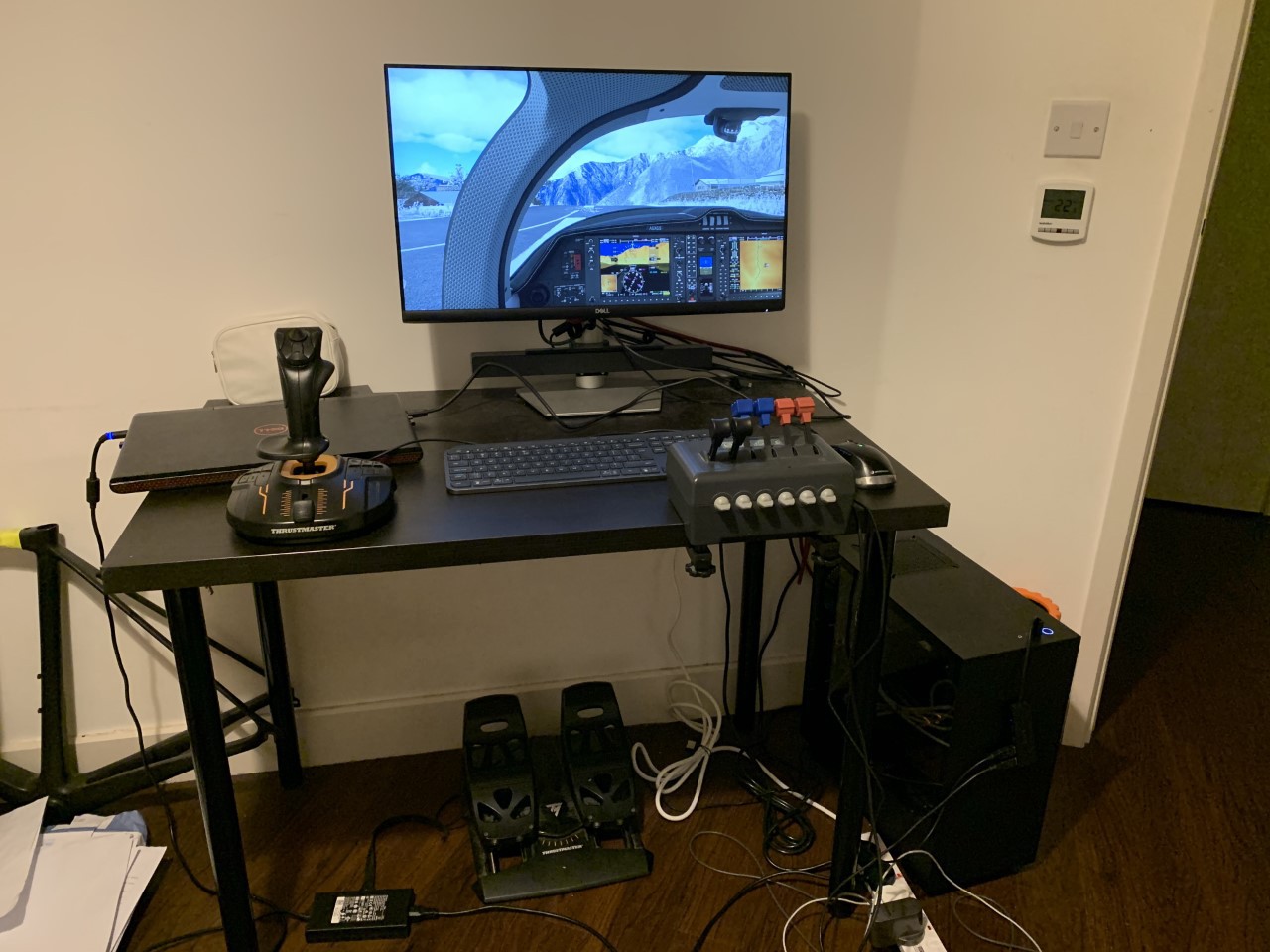
Let?s start with the good points of this game: the scenery, atmospheric modelling, and rendering.
Scenery
The scenery in this game is uncannily realistic. As has been touted by many a reviewer, it is genuinely possible to navigate using real-world VFR landmarks. Most of my training is done out of CZBB in Vancouver, BC, and I can look out of the cockpit and see all of my VFR departure checkpoints and enroute waypoints exactly where I expect them to be.
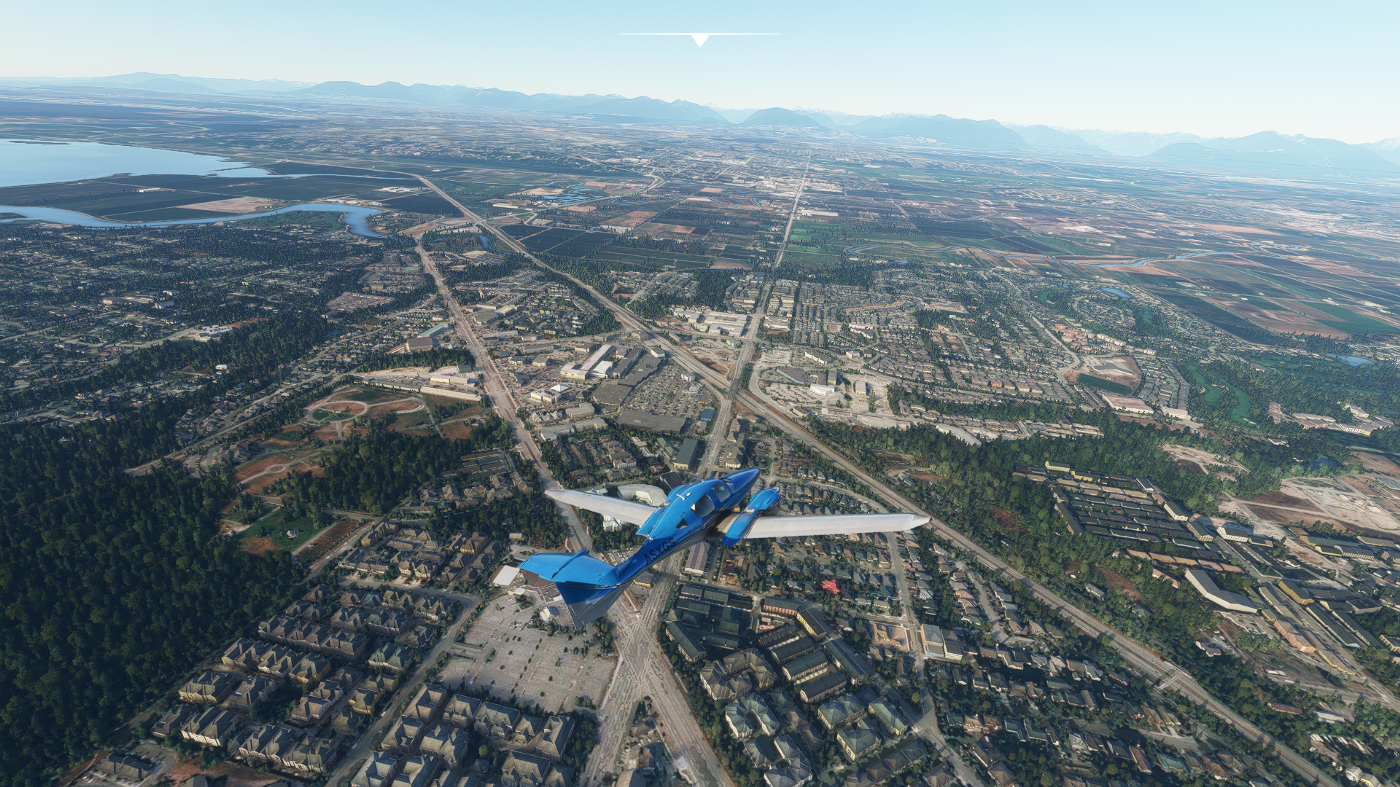
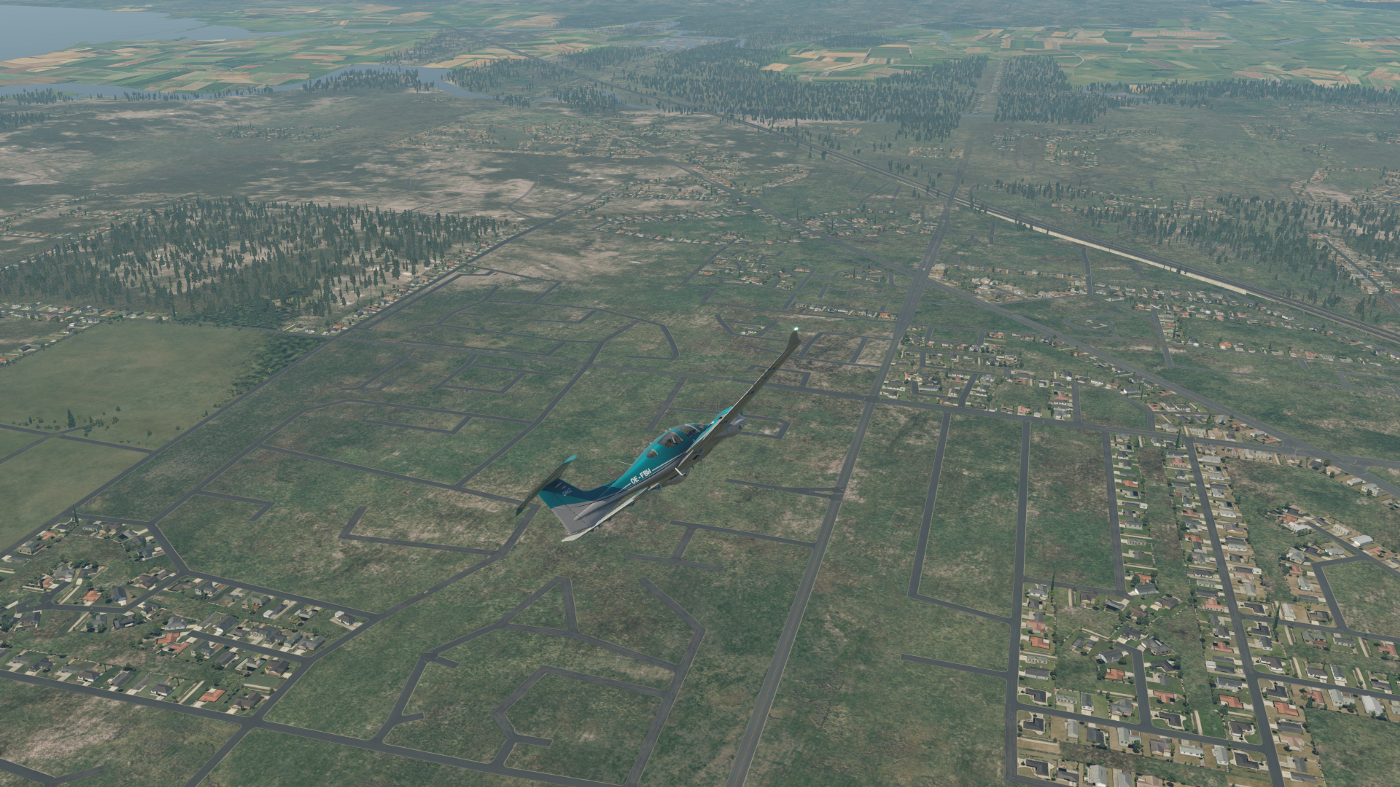
This is largely down to the use of satellite imagery ? OrbX?s scenery for FSX and XP11 are similarly accurate, but what sets FS2020 apart is the use of machine learning algorithms to ?map? terrain data to structures that look right. A major pitfall of the default and aftermarket scenery packages for other simulators is that outside of specially modeled areas, like cities or airports, most of the scenery is flat or randomly dotted with structures. FS2020 fills in buildings in a way that looks believable. The algorithms have been trained to put the right type of building in the right place: if there?s a high-rise, it?ll put a high-rise. It probably won?t look the same as the real structure, but it?s good enough to make you aware of its presence and feel, viscerally, that you?re really there.
Take the Golden Ears bridge across Vancouver?s Pitt River for example. In real life, it?s a suspension bridge. In FS2020, it?s a flat bridge. Critically though, you feel, thanks to the photo-realistic rendering, that it really is the Golden Ears bridge, and you respect it in a way you don?t respect the ?road across the water? in XP11.
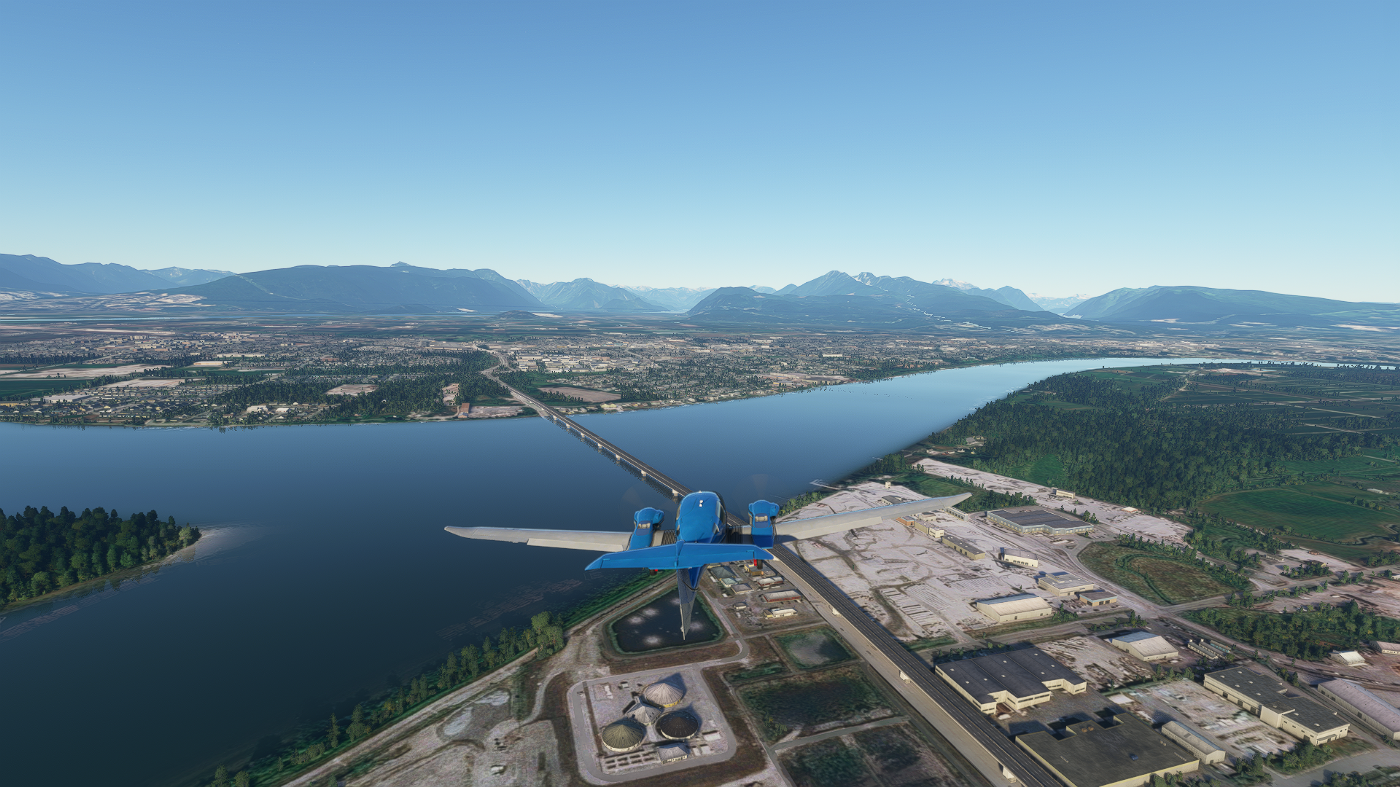
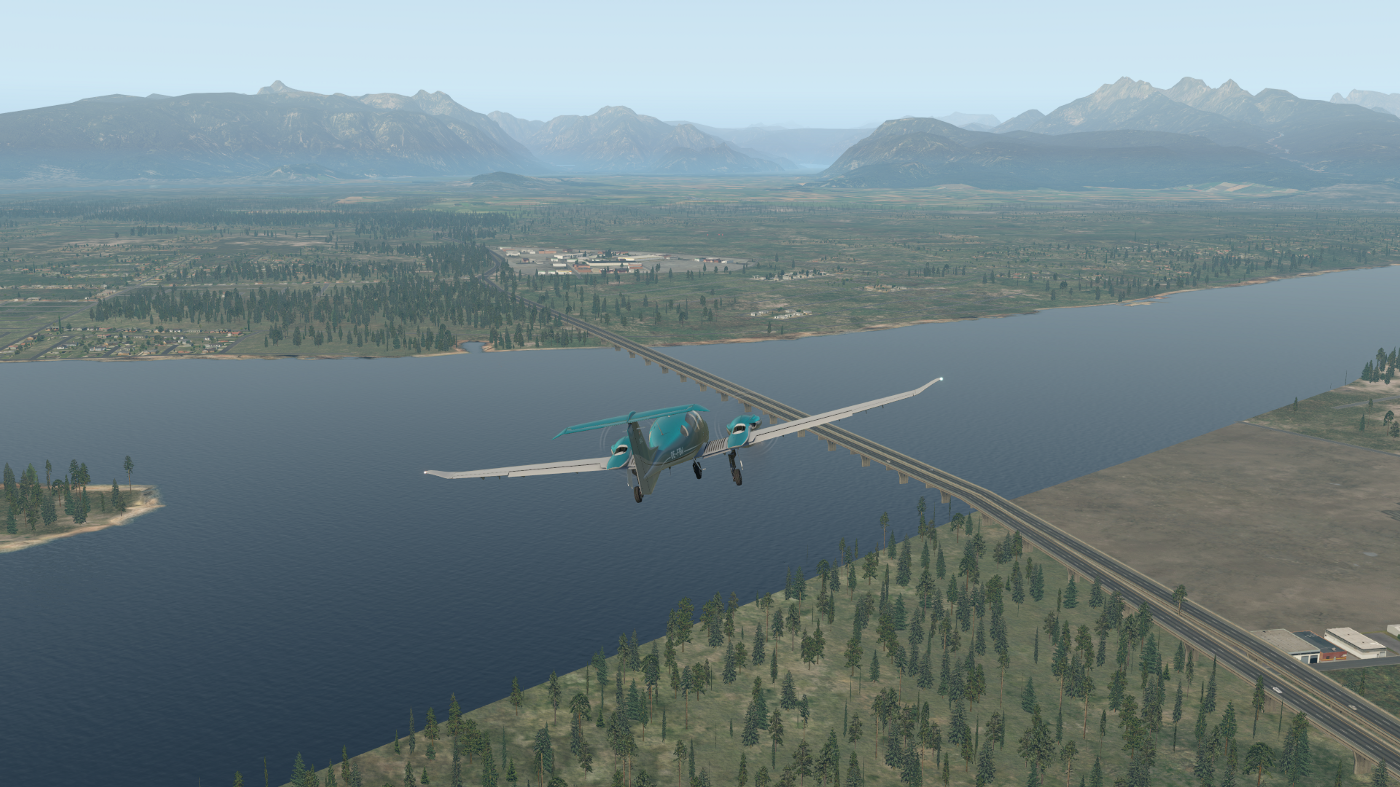
Similarly, the vegetation, though slightly overdone, has a visceral feel to it that you don?t get from the sparse-at-best foliage in XP11. You respect trees when flying your approaches, or picking fields for forced landings, in a way you don?t in other simulators. My ?squee? moment was flying over Vancouver Harbour and seeing the sulphur piles rendered in glorious 3D.

Atmospheric Modelling
Similarly, the atmospheric modelling is fantastic. I don?t know exactly how it works, but I know that unlike XP11, it doesn?t use a stratified model of the atmosphere ? the air isn?t divided into layers with different weather settings and an interpolation in between. Somehow, the air in FS2020 is a 3D field, and you really feel it. You get subtle little knocks and bumps from localised thermals and turbulence that you don?t get in XP11, even on live weather. I haven?t yet worked out if flying over water is smoother than flying over land on a hot day, but I wouldn?t be surprised to find out it is. Visually, it also looks amazing with haze, precipitation and clouds stunningly rendered. When sunlight enters the cockpit, it creates a genuine glare that makes you raise your hand up.
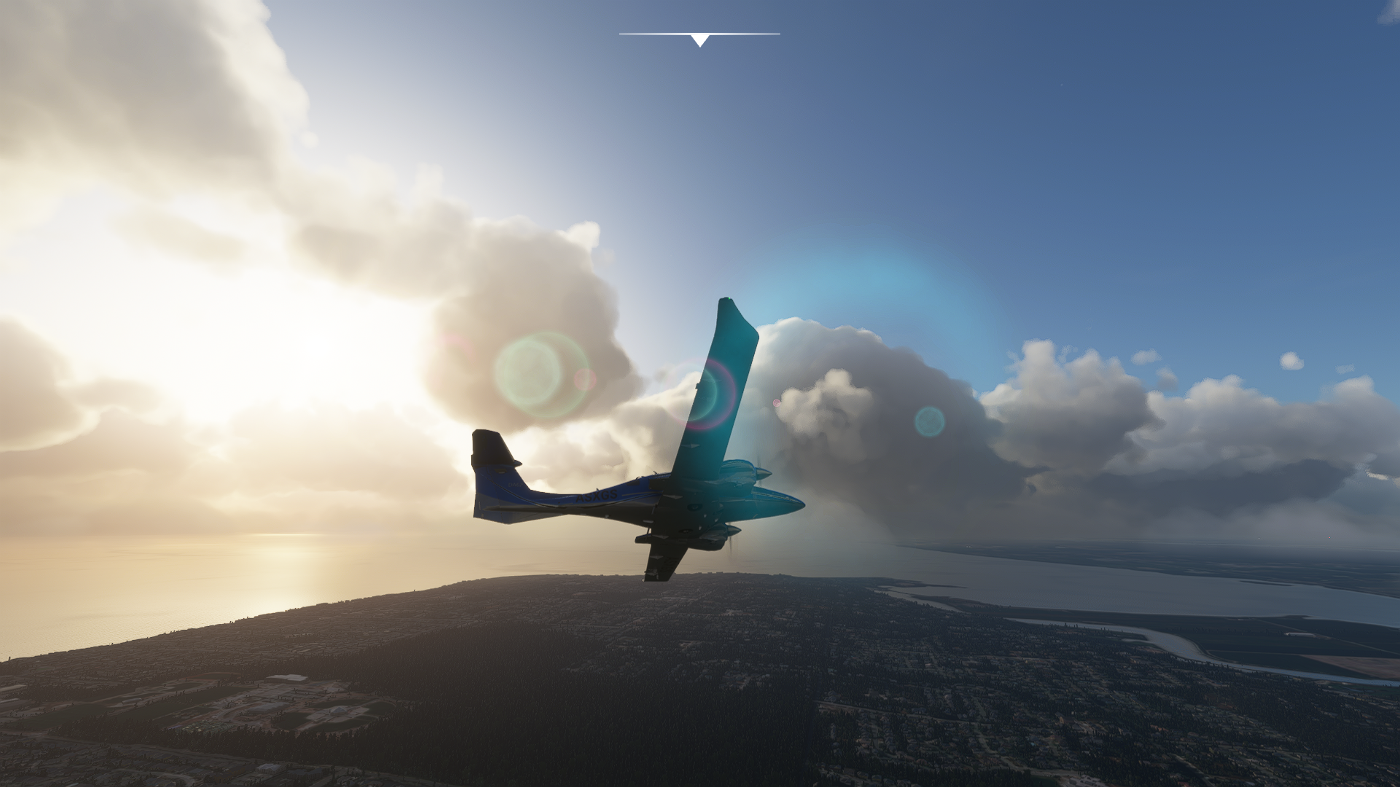
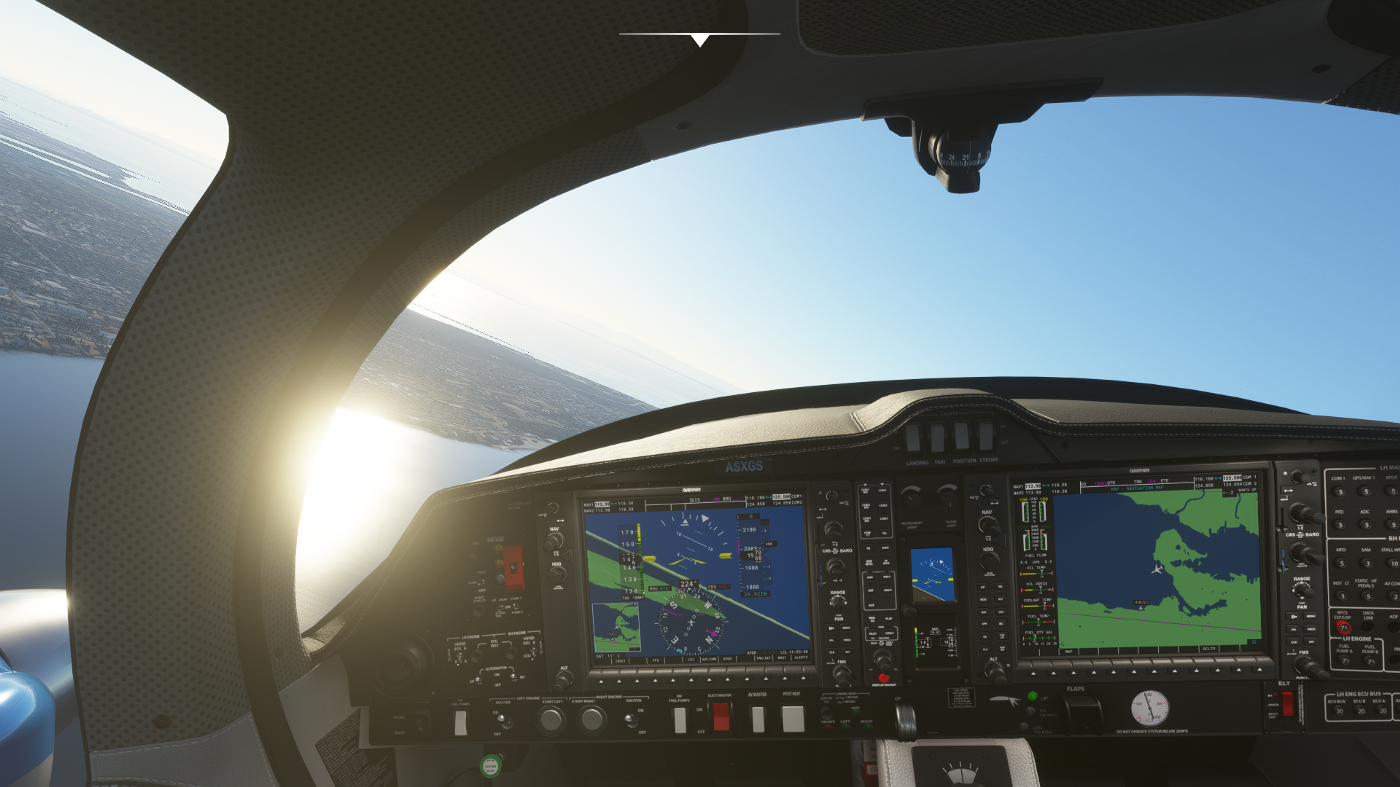
Rendering
The rendering in this game is gasp-worthily good. Calling it photo-realistic is no exageration ? when I was putting screenshots in this piece, I actually did a double-take on some thinking they were photos. The level of detail is stunning. I love the subtle weathering of the suction cups marks and fingerprints on the window of the DA62. I also love how the displays flicker when you view the plane from the outside, and how the spinning propellors catch the light. Really, I could go on all day about how amazing the rendering is. My only criticism is that some of the textures in the cockpits are a bit ?plasticky?, and I?d prefer some weathering on the exteriors over the ?factory fresh? looks, but really that?s it.
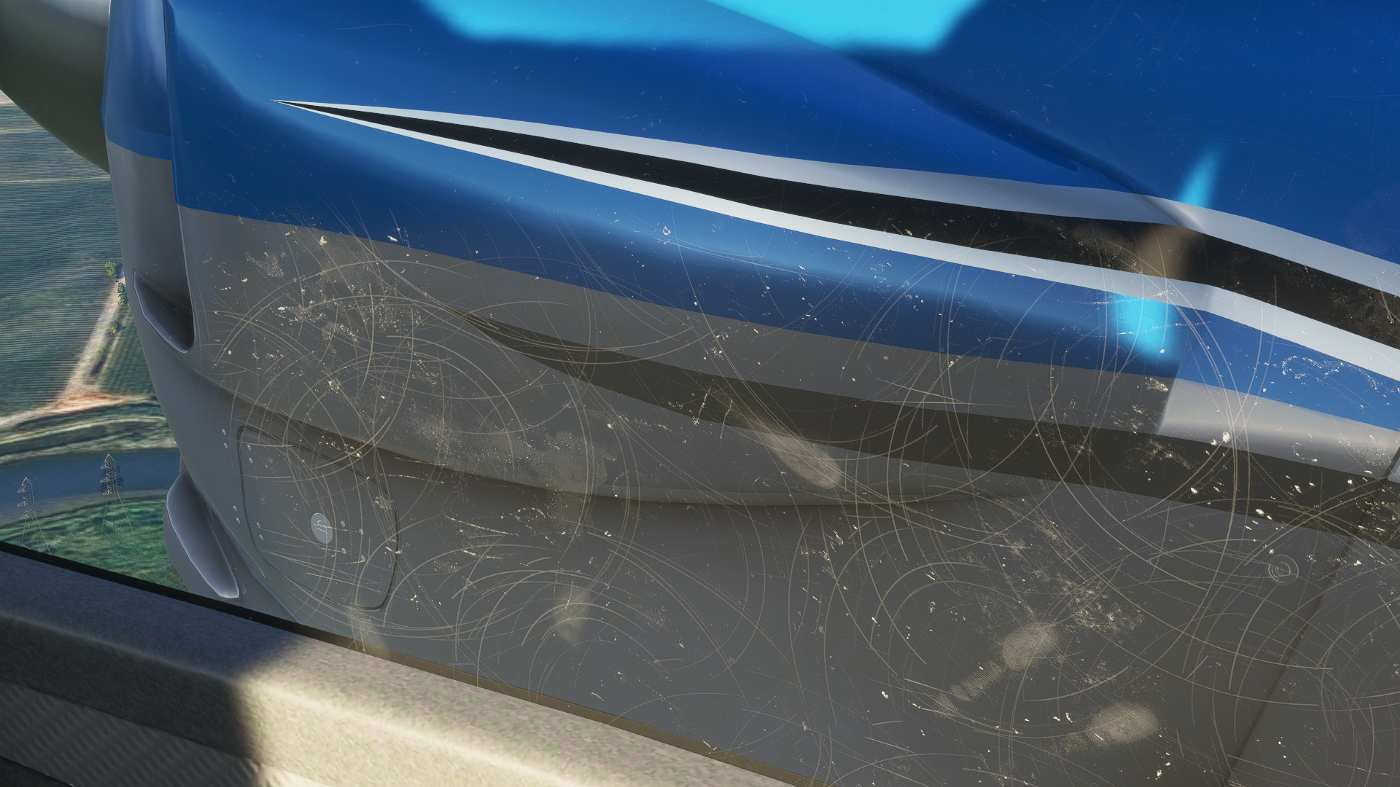
Sadly, the visuals are where the good things end for me. My complaints with the simulation in FS2020 come down to two things: the realism of the flight model and the realism of the systems modelling.
The Flight Model
Let?s start with the flight model. I?ll begin with some background about two different approaches to flight modelling that flight simulators use: the lookup-table and blade-element modelling. This is how a simulator ?works out? how an aircraft will respond to given inputs. For those who already know this, feel free to skip to ahead.
The lookup-table approach (most famously used by FSX) is to take known data about how an aircraft will perform and create a database of all of these numbers. For example, I know that 29.7″ of throttle, 2380 RPM, and pitching for 70kts in a DA20 A1 weighing 1500lbs will give me about a 700ft/min climb rate on a standard day. I also know that the POH is full of this kind of data ? we can just shove that into a giant database.
But wait, I hear you ask, how do we account for all the things that aren?t in the POH? What about all the situations that are in the middle of, or outside of our data? Well, that?s okay. For the values we don?t have, we can use some type of interpolation or extrapolation to work out what the value will be.
An advantage of this approach is that it?s simple ?the computer just needs to check the table and, if needed, figure out what the performance should be from the available data. A major disadvantage of this is that it?s not very good at capturing aircraft dynamics in the non-linear part of the envelope ? things like stalls and engine failures. When the behaviour of the aircraft becomes non-linear, it?s very difficult to use extrapolation to work out what will happen, because none of the data you have will help you work that out. Take the Cl/AoA curve. Generally speaking, up until stall, you have a very nice straight line. But near or at stall, and especially post-stall, the data you have will tell you nothing about what will happen. Your straight line extrapolation will diverge rapidly from the real data. For a lookup table to work properly, you?d have to have this non-linear data ? and FSX didn?t. This is one of the reasons why FSX was known for having very unrealistic stalls, and generally having lousy handling when performing aerobatics or abnormal maneuvers.
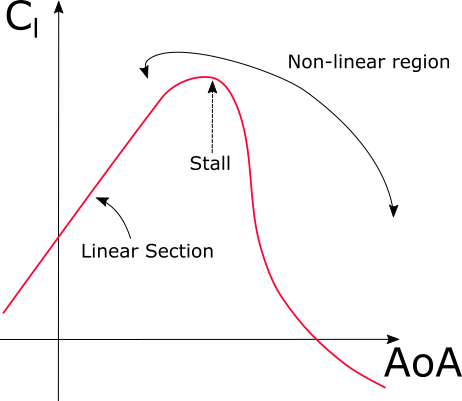
X-Plane was a game-changer when it arrived because it uses something called blade-element modelling. Without getting into the aerodynamic nitty-gritty, it breaks a wing down into many 2D sections, and calculates the aerodynamic circulation around each one? basically, how much lift and drag would be generated for the given conditions. By integrating across all the sections, you end up with a lift and drag distribution which you can use to work out the roll, pitch, and yaw response of the aircraft. This is far more realistic than a lookup-table because you?re not relying on pre-existing data ? you?re working it out in real time. A disadvantage of this is that it makes your computer sweat from the calculations. It also isn?t perfect at capturing non-linear behaviour. You still have to have equations to model the non-linear regimes, which are even more computationally intensive than linear envelope. So blade-element modelling isn?t perfect, but it?s far more realistic than the type of lookup table you find in FSX .
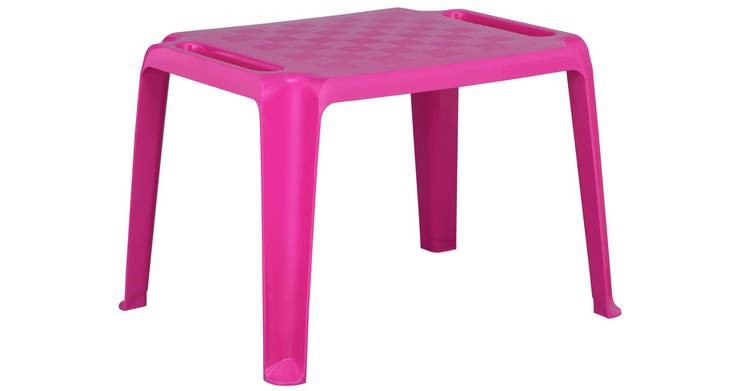
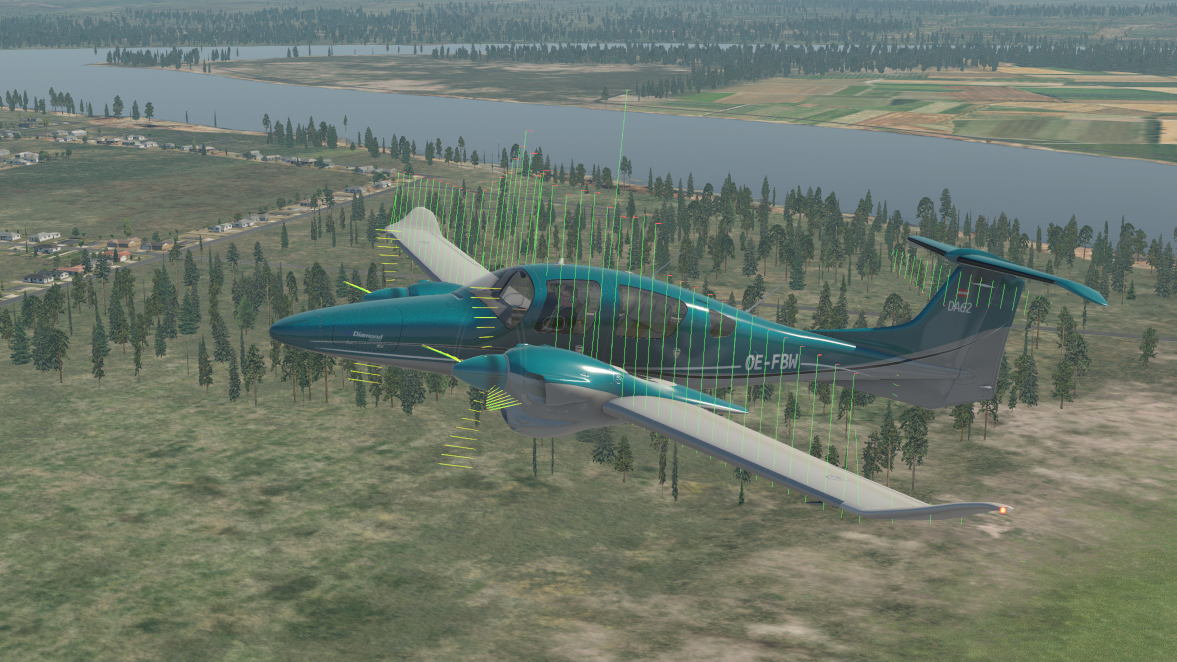
I?ll confess that I don?t know that type of modelling FS2020 is using. But given how it feels, and how it?s the child of FSX, I?m inclined to think it?s using a lookup table. This isn?t necessarily a problem ? a good lookup table with many data points could be just as good, if not better than, a blade-element model. Unfortunately, FS2020 doesn?t seem to have a good lookup table. The the linear behaviour unrealistic and the non-linear modelling is terrible.
As it?s an aircraft I?m familiar with, I?ll limit the scope of my criticisms to the DA62, but I highly doubt this is the extent of FS2020?s problems. Hold on, I hear you say, didn?t I say I flew the DA42, not 62? Yes, that?s true. I?ve never flown the DA62 in real life or on a DSim. But in terms of handling and procedures, they?re almost the same aircraft. The DA62 is slightly more powerful, slightly heavier, and has slightly more yaw authority than the DA42, but the two are closer to variants than distinct types. Certainly, if you check the POH, the two are almost identical in terms of procedures. I think, therefore, I?m in a reasonable place to comment on the realism of FS2020?s default DA62.
I?ll be comparing FS2020?s effort to the payware Aerobask DA62 for XP11. And before anyone complains that it?s not fair to compare payware to ?freeware?, I don?t think the payware-freeware argument applies here. We?re talking about an aircraft that was developed by a team of Asobo professionals ? not someone?s side project. I don?t expect the same level of detail I get in the Aerobask model, but I do expect performance and handling to be there or thereabouts. I should also add here that when it comes to my systems criticisms, the Aerobask DA62 uses the default XP11 avionics suite, so the functionality comparison is completely fair. And not to points-score, but the cost of XP11 and the Aerobask add-on is less than the cost of the standard edition of FS2020.
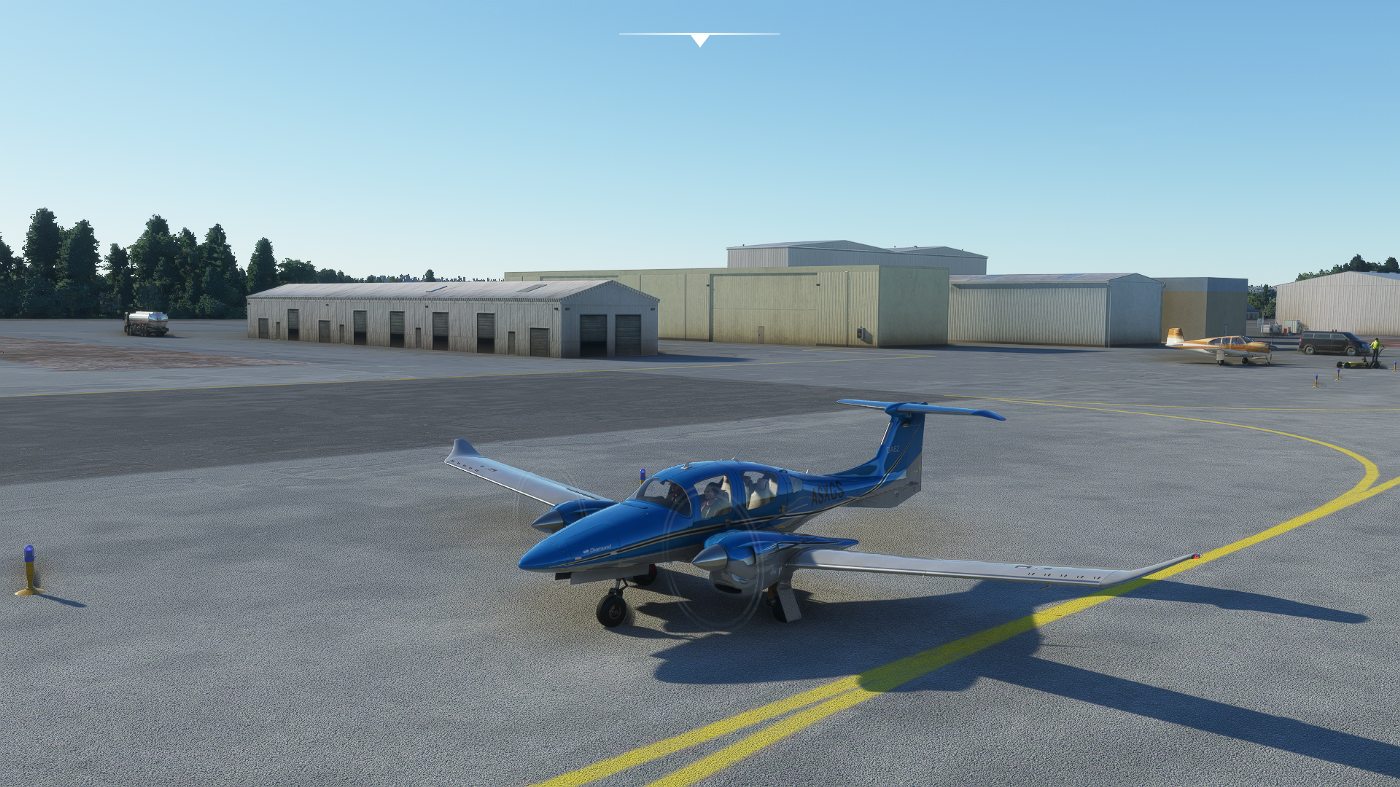
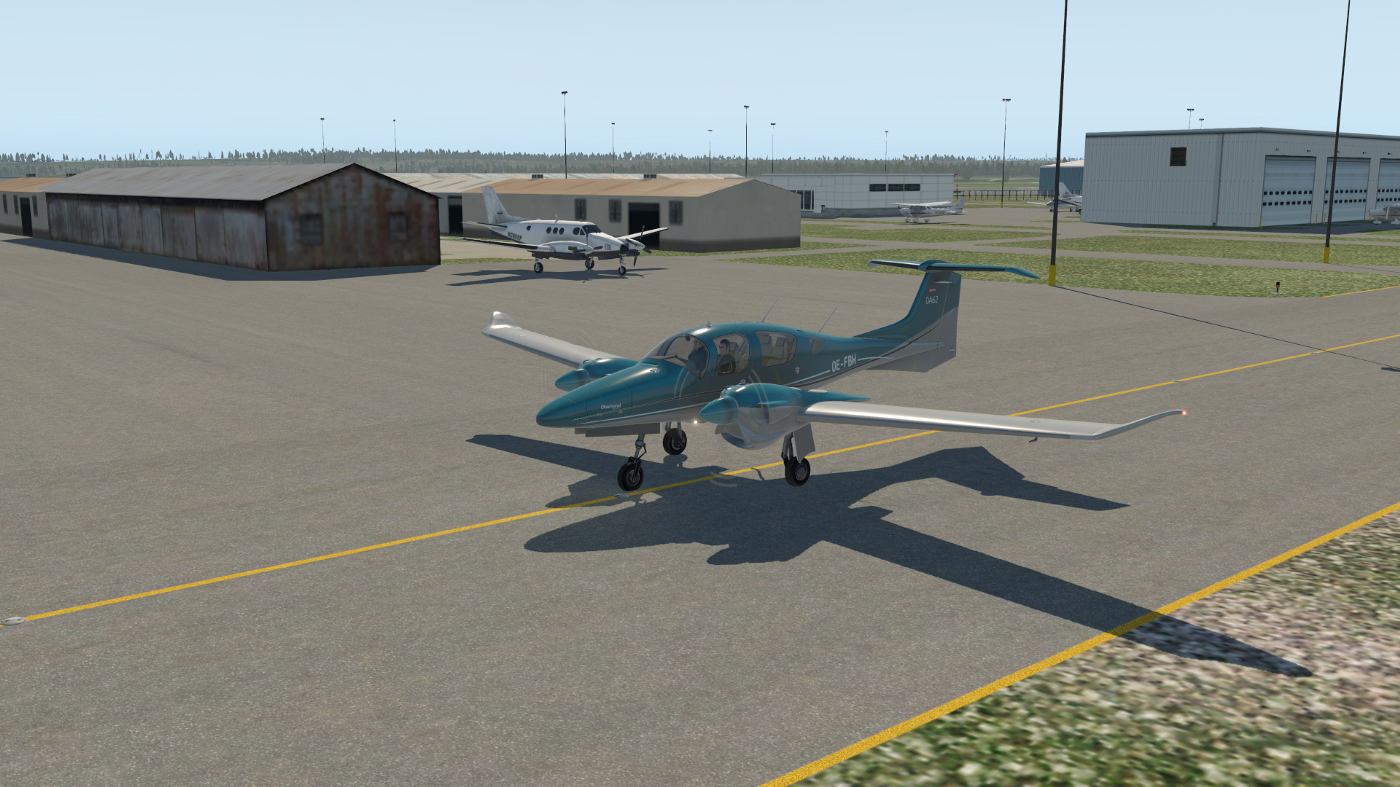
Takeoff
Let?s start from takeoff. The acceleration in FS2020 is tardy to be generous. On the DA42, with only 130 horsepower per engine to the 62?s 180, when you push full throttle, the plane goes. It also produces a very strong amount of adverse yaw (thanks to having non-counter-rotating propellers), and you need a lot of rudder to keep it on centreline. The FS2020 DA62 does none of these things. It takes around 10 seconds for the plane to reach 30kts (compared to the real plane?s 3?4), and the takeoff roll is monstrously long ? half-fueled with two people and no luggage. At CZBB, halfway down runway 07/25 (around taxiway C) is our reject point in the DA42, but we start our roll from the threshold which is already 600′ down the runway. We?re usually airborne slightly before taxiway C. In FS2020, if I start my takeoff roll from the very end of the 5606′ runway, I lift off at the same point. Yes, the DA62 is heavier, but if you check the POH in ISA conditions, a max T/O weight, flaps up takeoff has a ground roll of around 2500′ ? not 3100′. The configuration I flew the plane in FS2020 is nowhere near max T/O weight. Moreover, in XP11, the DA62 at max T/O weight gets off the ground in the stated POH distance, and in the same configuration as FS2020, well before taxiway C.
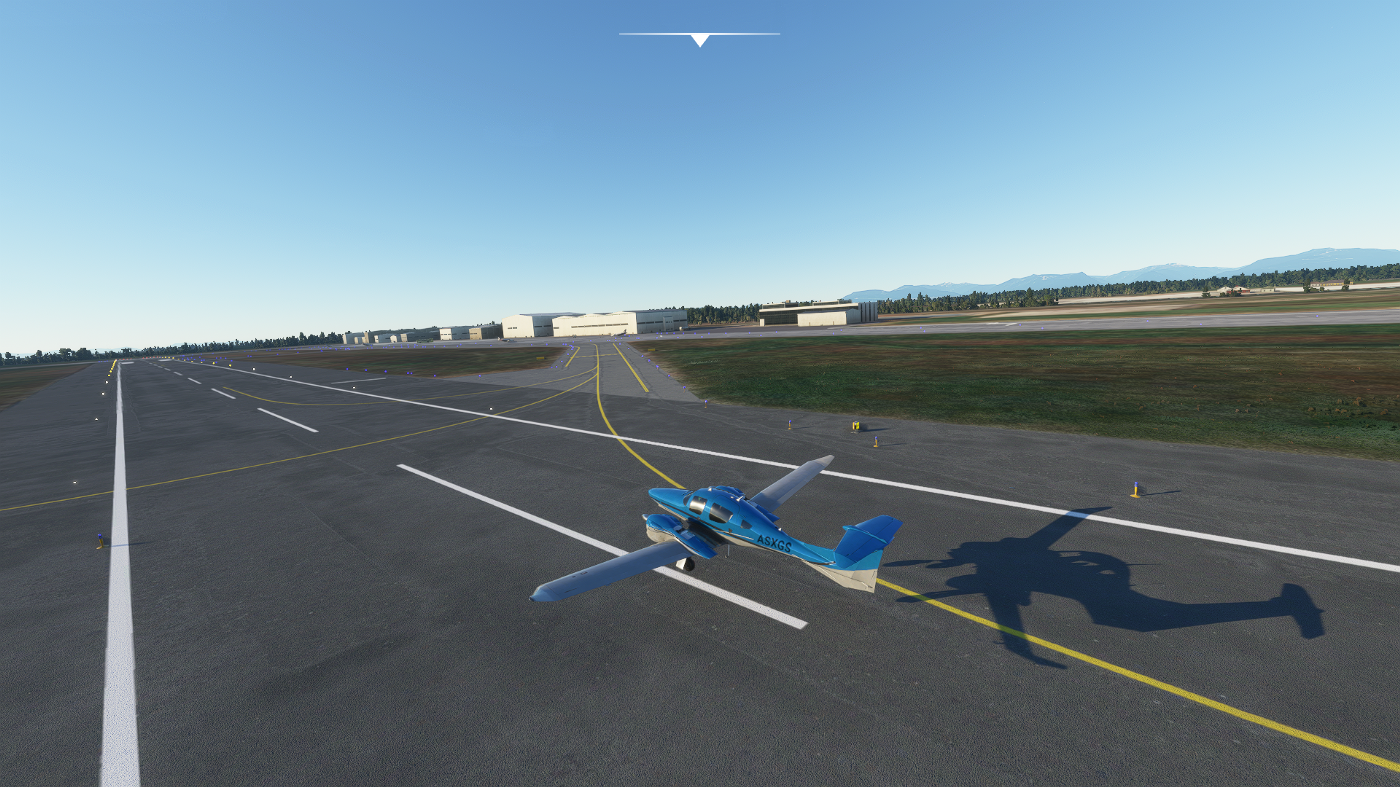
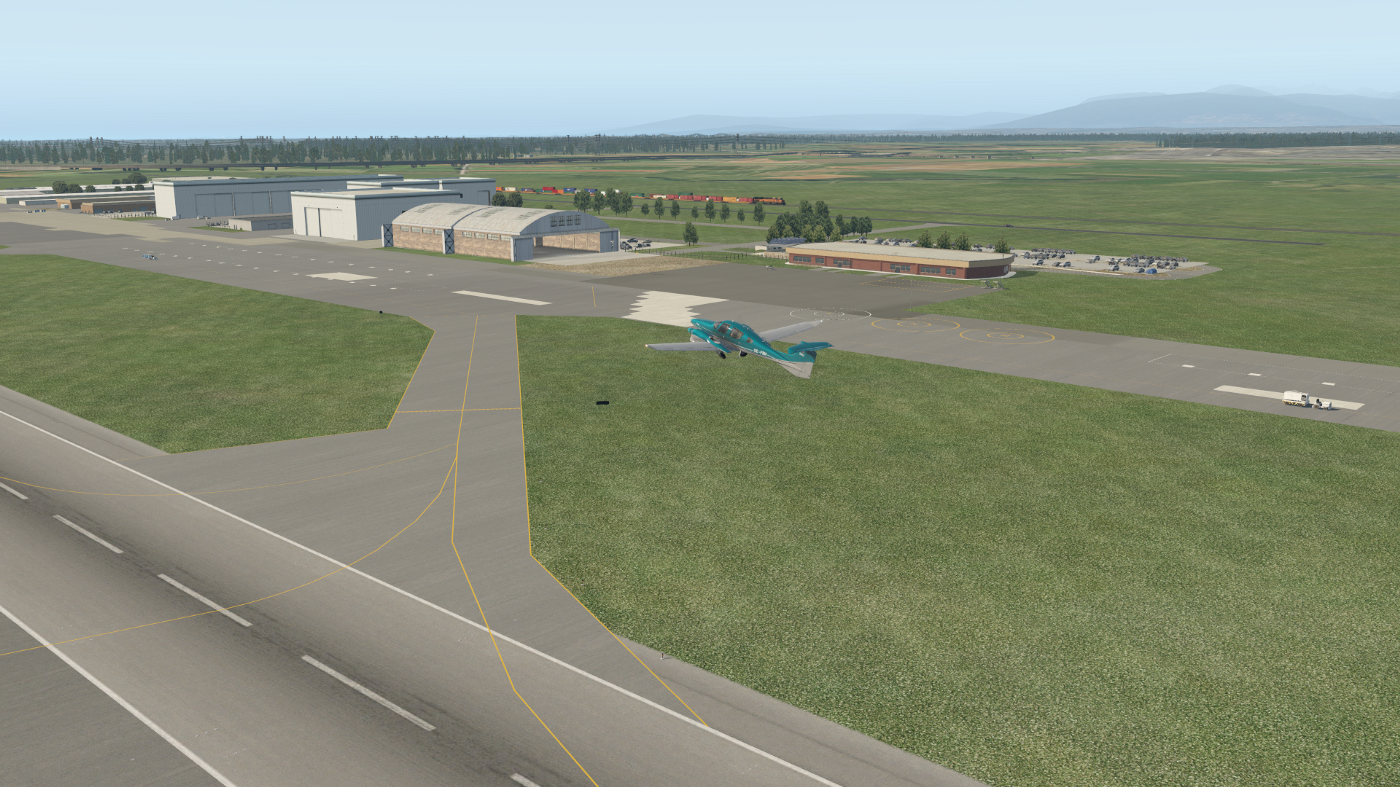
Another issue is that the engine response is totally unrealistic. The real engines, despite being turbocharged, are respectably responsive to throttle inputs. They are not, however, instantly responsive in the way they are in FS2020 ? there is some spool up/down time.
Climbing
The DA62 in XP11 is an impressive climber, easily clocking 1600ft/min climbing blue line, flaps up. The real life DA42 can manage about 1100ft/min in the same configuration. Now, in XP11 and in real life, to prevent damage to the engines, you usually throttle back to 2200RPM (max green arc), which reduces performance. For testing purposes though, I went for max RPM. In this configuration, the DA62 in FS2020 seems underpowered, managing only 1300ft/min at slightly under 15 degrees.
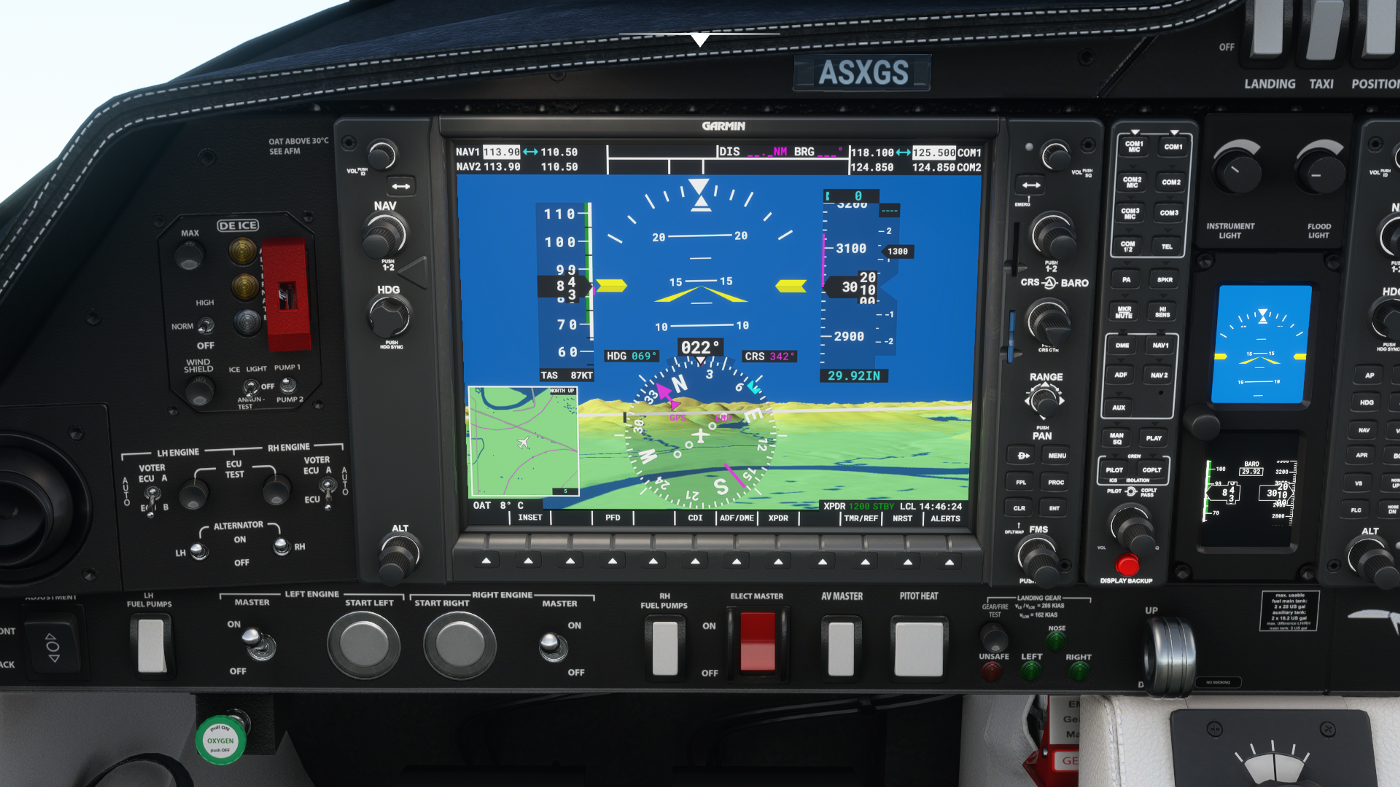
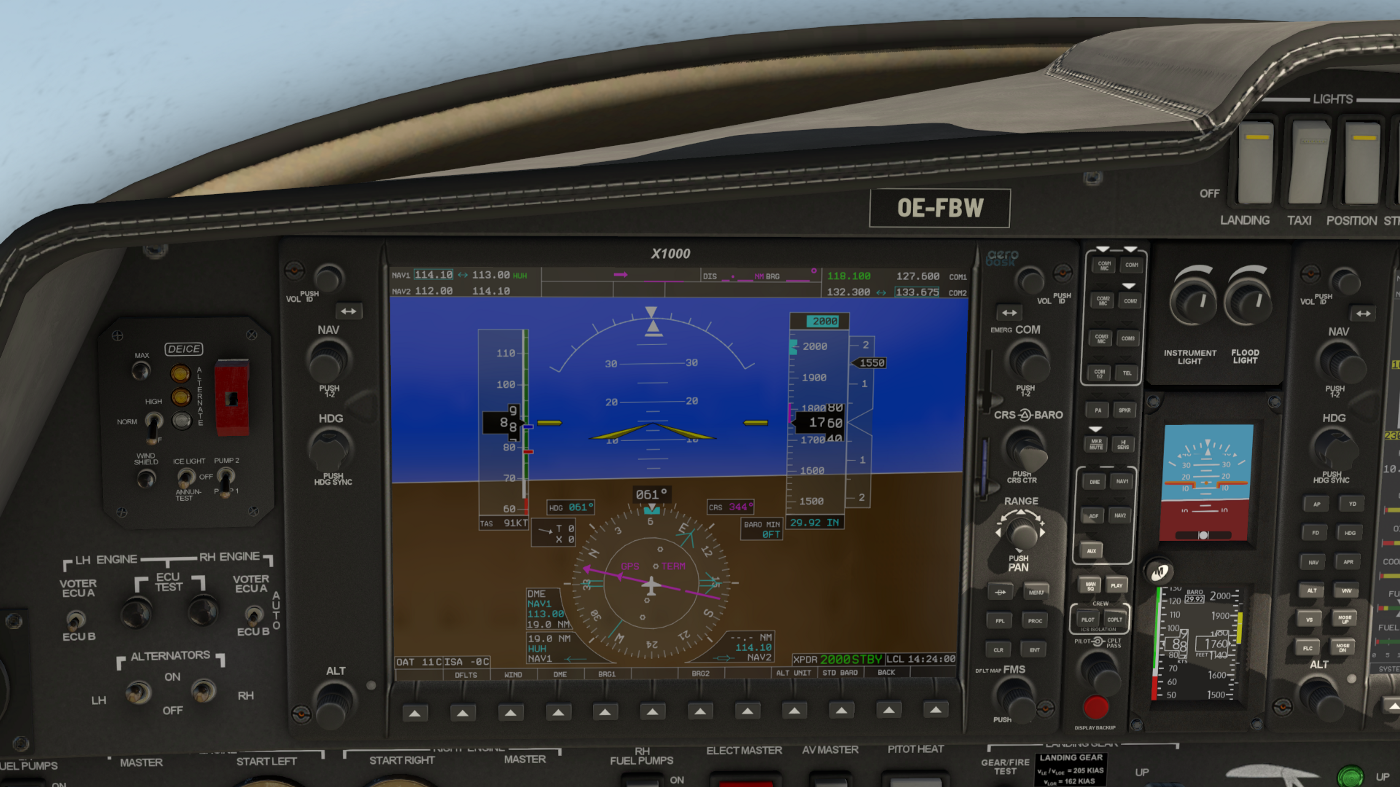
The DA62 is also quite a pitch sensitive aircraft. Small changes in attitude have a big effect on climb performance and speed. Whatever lookup-table FS2020 is using has completely failed to capture this.
Straight-and-level
In level flight, high speed cruise of 70% power gives about 150kts, and the nose should be right on the horizon line of the PFD. XP11 captures this perfectly. In FS2020, I get about 120kts and I have to pitch to about 2.5 degrees nose up. There?s a reason for this I?ll get into later, but, in the cockpit, the figures are totally off.
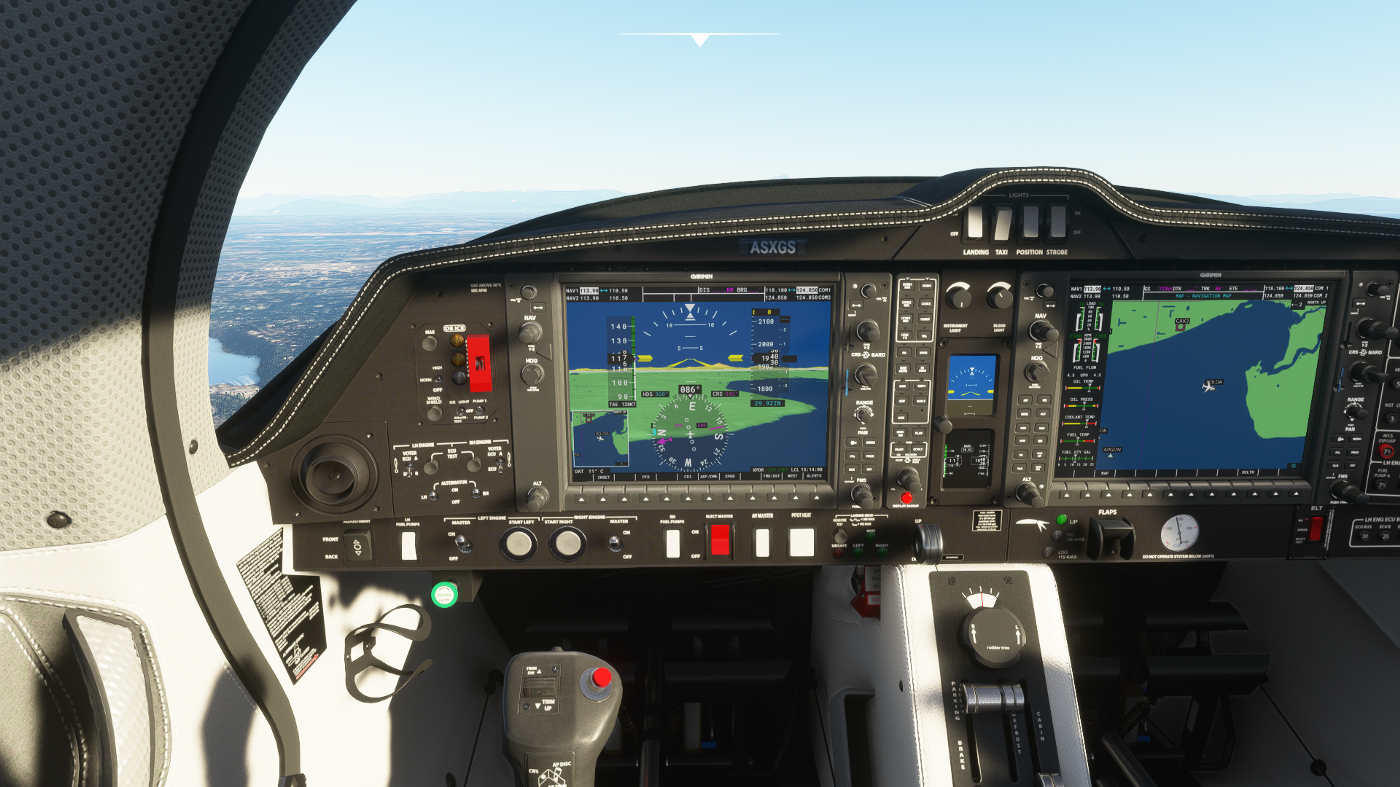
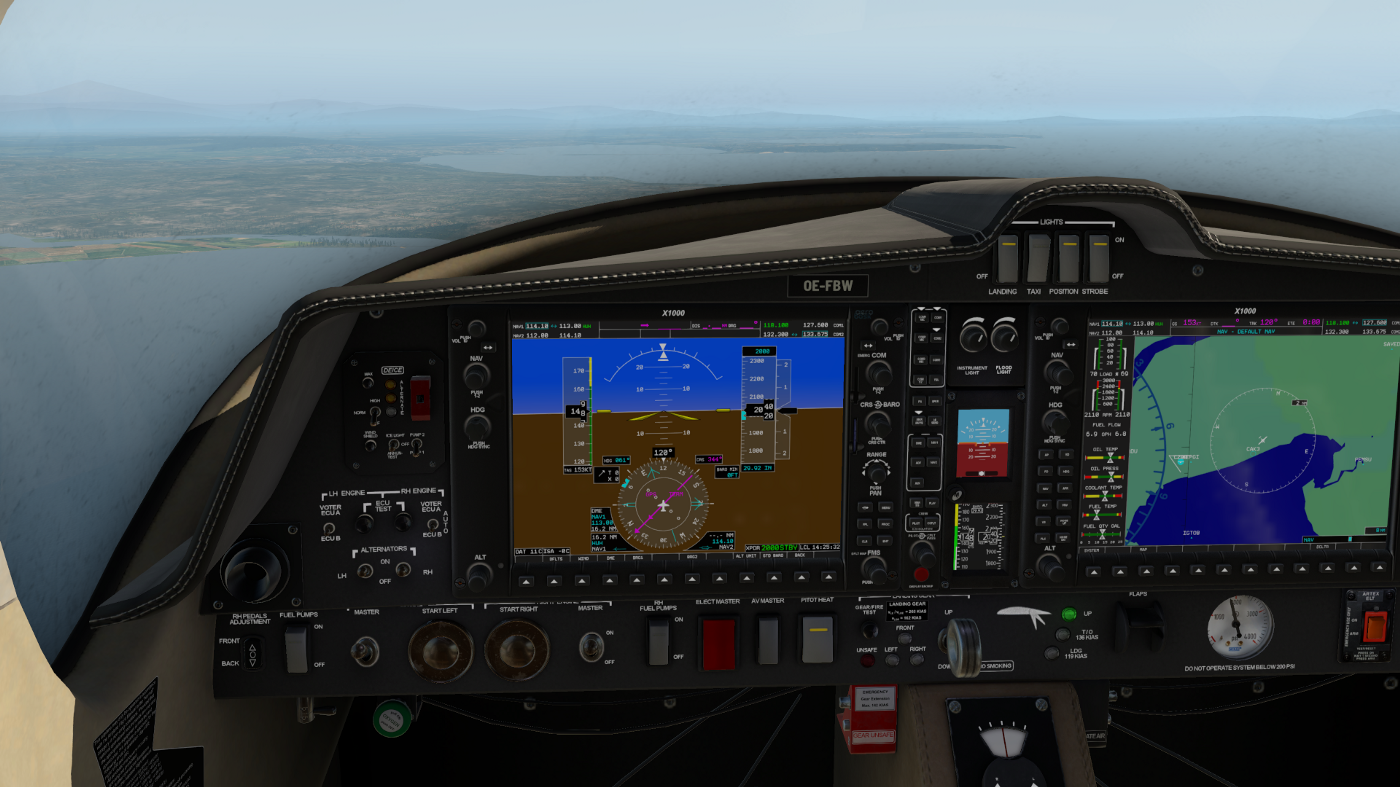
Maneuvering is laughably easy ? and not because the aircraft handles nicely. It?s easy because the aircraft feels like it has no inertia. Yes, the real plane is very maneuverable and responsive, but there?s a ?weight? to direction changes which is completely missing. In FS2020, you can instantly pull 60 degree or more turns, and exit them just as quickly. In XP11, there?s a residual tendency to turn that you have to arrest when exiting a maneuver.
Descending
Let?s start with the configuration changes. Dropping takeoff flaps in the real aircraft is an big kick of lift that requires anticipation and effective re-trimming to maintain a glidepath. When I was first acclimatising to the aircraft, I?d often end up going from -600ft/min to +400ft/min on the approach by dropping takeoff flaps. And it?s a kick ? not a gradual change in vertical speed. In FS2020, you drop the flaps, and nothing happens. Then, very slowly, the plane slows down and might climb a little bit, but nothing a little forward pressure can?t fix. By contrast, XP11 captures the ?kick? perfectly.
FS2020 also has the landing gear dynamics totally wrong. The gear on the real DA42 are not very effective at producing drag. You can hear them, but the speed degradation is quite gradual compared to the flaps. FS2020 has taken this too far and the gear does nothing to reduce your speed.
Performance-wise, it?s a similar mess to straight-and-level. Landing configuration in the real plane with 40% power and a -2.5 degree approach attitude should give 90kts and a -700ft/min sink rate. XP11 is a dead match for this. To achieve the speed and sink rate in FS2020 however, you need 70% power (in cockpit view) and the attitude is above the horizon. Even disregarding the power settings and flying purely to speed and aiming point, the attitude is much too flat ? more like an airliner that a light twin. On the real plane, you have to fight the sensation you?re going to hit the nose on the runway.

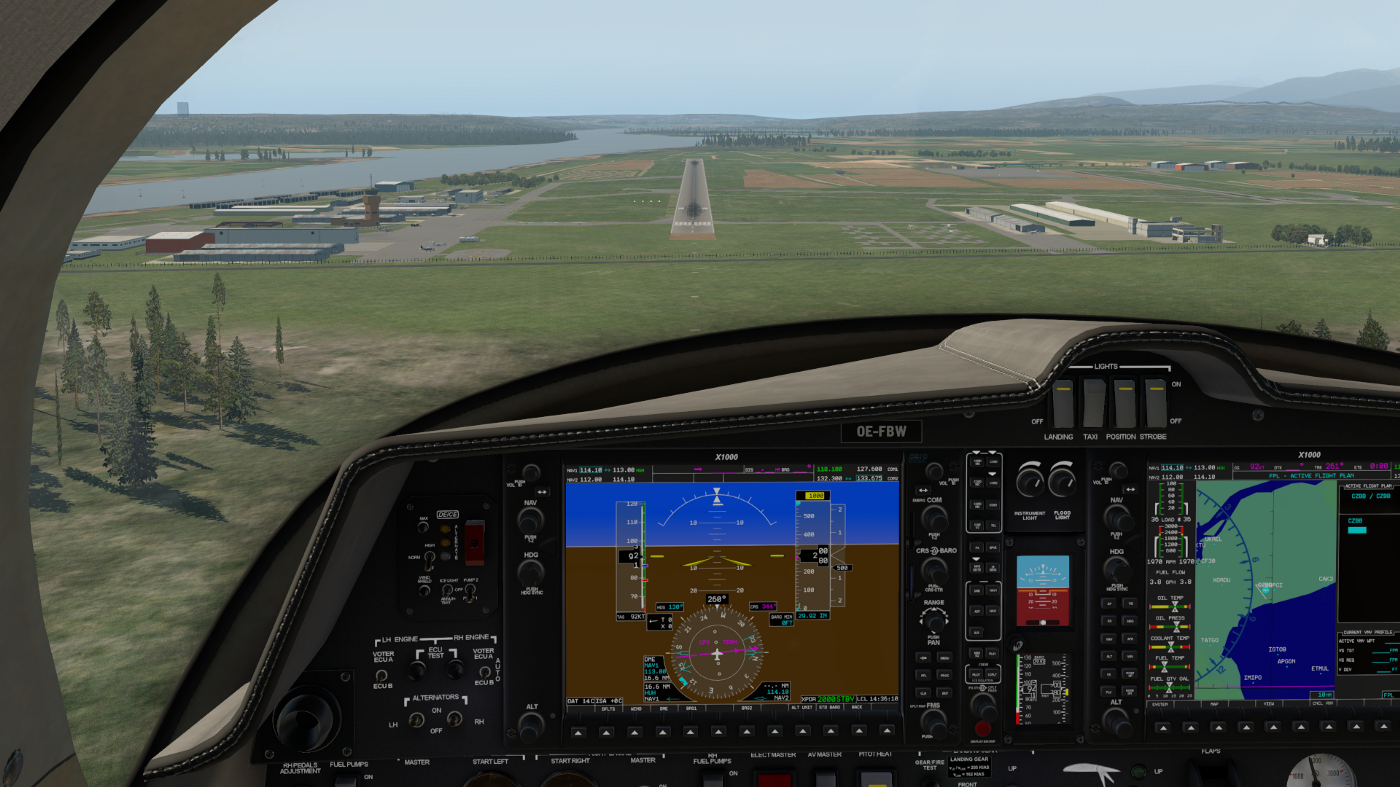
Landing
Landing is a bizarre affair in FS2020. To be fair, they?ve captured the long flare of the real DA62 well, but the controls in ground effect feel too light and sensitive. Everything looks alright performance wise, but it feels very wrong as you make a frenzy of micro-adjustments in the round-out. Also, the brakes are far too powerful, and there?s no simulation of locking. You can bring the aircraft from touchdown to a dead stop in 400′. It?s true that XP11 has no ground handling model to speak of, but you can lock the brakes, and stopping distances are far more realistic.
Thought that was it for the flight model? Oh no, we need to get to the bad stuff now! Light twins like the DA62 are notorious for having strong yaw dynamics when an engine quits ? especially the DA62 because it has an aerodynamically critical engine. Rudder is essential, as is pitch control. There is also a substantial performance loss. Climbing blue line single engine in a DA42 will give you about a 250ft/min climb rate with a 2.5 degree attitude. That?s roughly a 75% loss of climb performance compared to having two engines. The DA62 has more power, but it will barely scrape 400ft/min. XP11 is a okay-ish match for the yaw (even the DSim struggles to match the real plane), but the climb performance pretty spot on.
In FS2020, shutting down the critical (left) engine in a climb caused absolutely nothing to happen. Sure, eventually the speed decayed a bit and the aircraft rolled slightly, but I had to check the gauges to make sure the engine was actually dead. Also, feathering the engine (which isn?t rendered) doesn?t do anything to change the aircraft performance. Speaking of performance, the plane seems underpowered (again). It barely manages 200ft/min, although attitude-wise it looks okay.
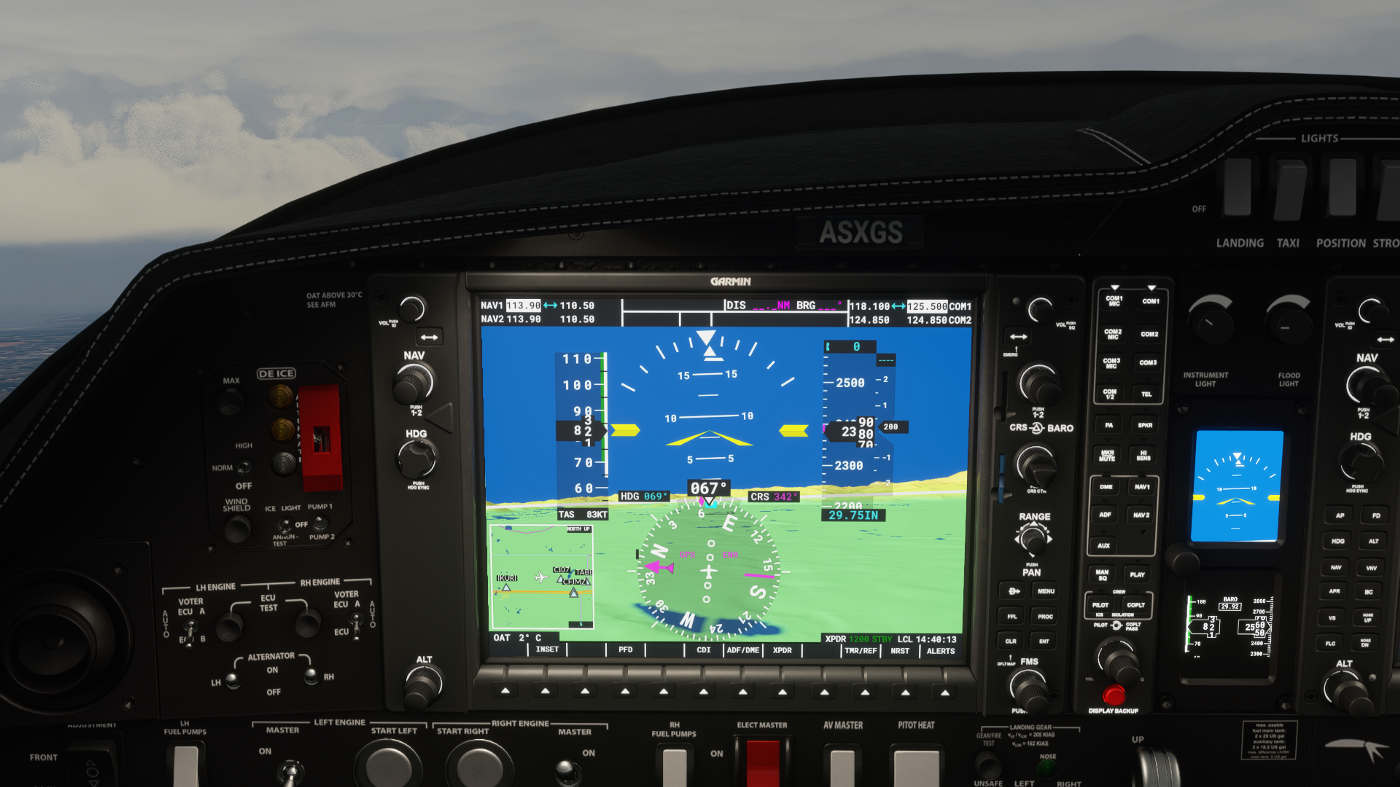

I admit that with both simulators, I?m surprised at how nose-high the attitudes are. It?s impossible to maintain this kind of attitude in a DA42 single engine. Given, however, they match and the POH has no specific information, I?ll assume the attitude is accurate.
Continuing with the poor engine failure dynamics, reducing speed to Vmca single engine in FS2020 results in nothing more than a benign stall warning. In the real plane, you?d have your live foot hard to the firewall and be pulling back power to the good engine to get back directional control.
You also can?t stall planes properly in FS2020. I won?t really go into this because the DA62 has very benign stall characteristics, but none of the feelings of aileron ineffectiveness or nose-heaviness are captured. If you want to spin, forget it. The only way I?ve found to do ?spin? is fly very close to a building without hitting it, which somehow breaks the game mechanics, drops all your flaps and gears, and pitches you into an uncontrollable tumble.
The Systems Modelling
The G1000
Let?s move on to FS2020?s woeful systems modelling. When XP11 came out in 2016, it had a fully functional G1000 facsimile (the X1000) that was equipped with a detailed and largely accurate navigation database. For flight planning and navigation, it?s a very good replica of the real G1000. When I started using the real thing, I remember my instructor was very surprised at how familiar I was with the system, and asked me if I had used Garmin?s own simulator ? the X1000 really can be that good a training tool. There are some minor things that are different ? you can?t do RAIM checks, for example ? but these are details rather than functionality compromises.
Sadly, the same cannot be said of the FS2020 G1000. At the most basic level, it looks nothing like the real G1000. In fact, generally the FS2020 avionics have a much lower standard of texturing and modelling than the 3D components. There?s no – texturing to the flags and ribbons, and the font is too narrow. It looks like a cheap knockoff of the X1000, which in turn looks like a knockoff of the G1000.
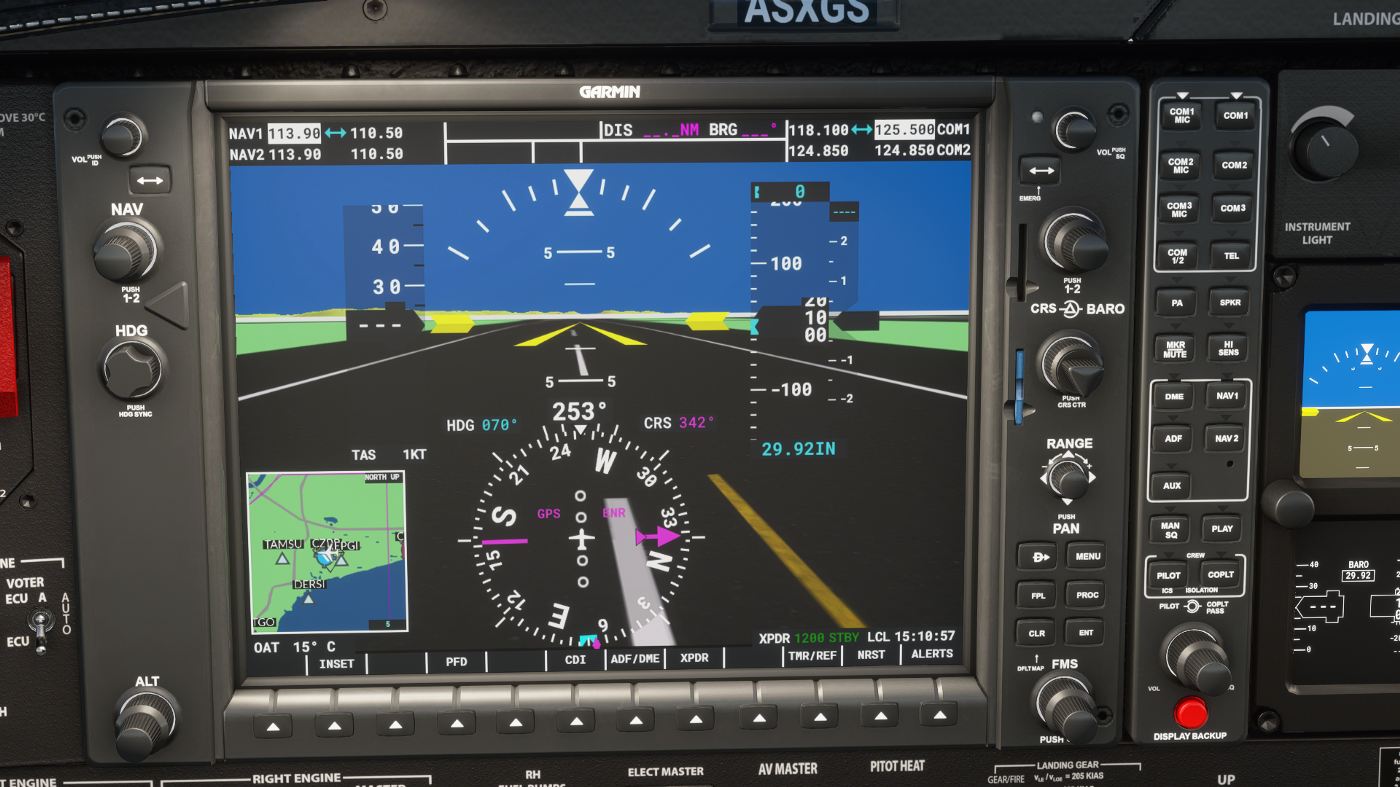
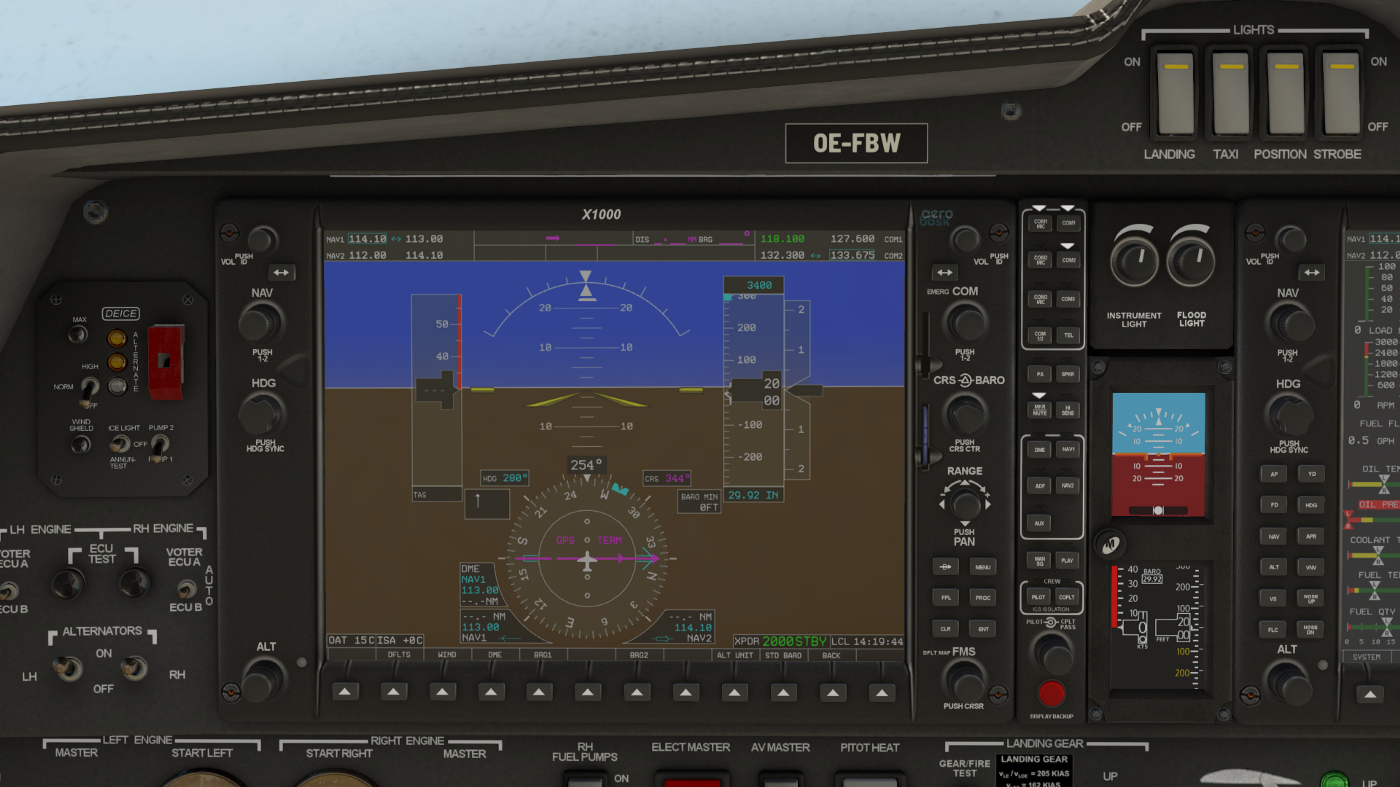
More fundamentally though, it?s not a G1000 facsimile ? not even close. The menu navigation is all wrong. You don?t need to press the cursor anywhere near as often on the real thing, and certainly not to make an input every time you enter a new page. Most glaringly, the navigation database is almost non-existent. In Canada, it?s limited to major commercial hubs or ?famous? airports only. CZBB, a major training hub and regional airport has no SIDs or approaches in the FMS. CYAZ, another popular and busy airport is also a complete blank. I?m pretty sure it?s the same worldwide from the brief look I?ve had. Of course, you can manually assemble a GPS approach overlay for a non-GPS approach, but this is tedious, time consuming, and totally unecessary in XP11. Don?t even bother trying to construct an RNAV approach.
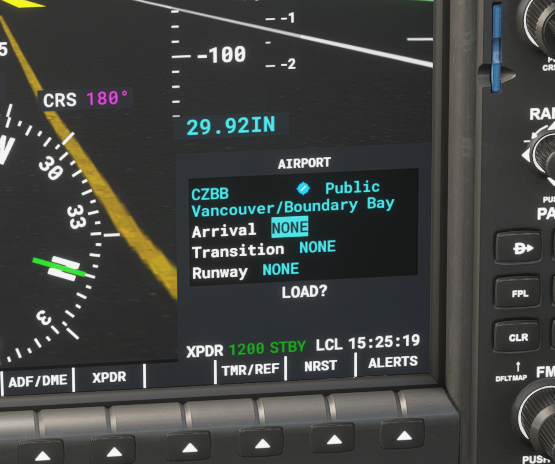

Elsewhere, the FS2020 G1000 (let?s call it the F1000) continues to lack basic functions. The most glaring of these is the lack of an OBS switch .The G1000s I?ve used in real life don?t have a way of creating holds at GPS fixes in the FMS, so you have to fly them using by pressing the OBS switch. This lets you manually set a course to a GPS waypoint, and suspends the auto-routing functionality in the FMS. The F1000 has neither the capability to create GPS holds in the FMS, or the ability to press OBS. Well, you can press it on the TBM930, but it does nothing. Additionally, the heading, course, and altitude sync bugs don?t work. When you press sync on the heading bug, it ends up 5 degrees out of alignment. Course and altitude don?t even have a sync button.
The synthetic vision on the F1000 PFD drives me nuts. In the real world, it?s a powerful aid when flying in IMC or conducting low-visibility operations on the ground. I don?t hate its functionality ? I hate that it exists in the F1000 and so many other fundamental systems don?t. Leave synthetic vision alone, Asobo Studios. Get the basics right first.
If you want to fly IFR, forget FS2020. I?m not saying you can?t do it ? the navaids are there and the aircraft are equipped to pick them up, but that?s not the point. You fly a glass cockpit environment for the systems integration, not to use the HSI as a glorified analog gauge. Using the real G1000, I fly NDB approaches by NDB, but I always have the GPS overlay there as a backup, and I use the cues from the GPS for reference. And even if I do just use the GPS overlay, I still tune the navaids so I can cross-check the position information I see. I don?t deny there?s value in ?old school? flying ? I love practicing in analog cockpits where I have no FMS auto-routing. But flying a glass cockpit is about using the integration and redundancy of multiple systems to make flying safer and easier. It?s not acceptable in 2021 to have a G1000 facsimile without a fully functional FMS and procedure database.
The F1000 also has very limited (and no working) systems readouts on the MFD. Remember how I said there was a reason why I was getting such poor performance out of the DA62? Well, that?s because in cockpit view, looking at the F1000 MFD tells you nothing about your engine parameters. I discovered this when I checked the engine gauges in external view (a point on this later) and noticed a 20% discrepancy in the power settings. Turns out, 70% throttle on the F1000 is actually 50% in simulation settings. This still doesn?t explain the unrealistic attitude ? in real-life you?d be looking at a smidge above the horizon on the PFD at 50% ? but it does explain the airspeed. The same applies to the power settings on approaches. This isn?t so much a simulation problem as a game-bug, but it?s beyond annoying.
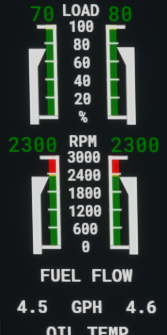
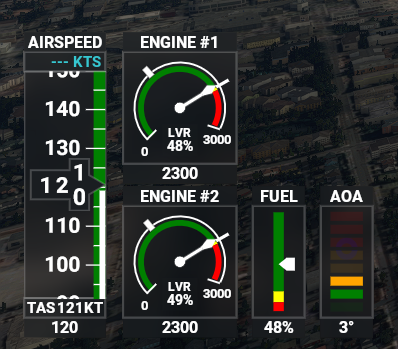
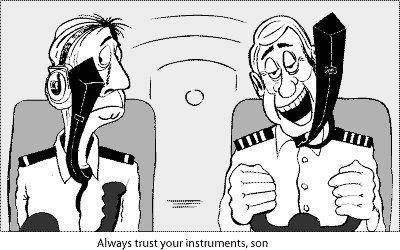
The only gauges which move on the F1000 in the DA62 are the throttle setting and RPM gauges. The oil pressure and temperature indicators appear static, and there?s no systems page so you can?t check the ammeter, voltmeter, or de-ice quantity. The TBM930 has some cool-looking gauges to check control surface deflection, but these don?t work either. Somehow though, the much older X1000 has a fully functional MFD that actually reads correctly.
The Virtual Cockpit
I also have some specific complaints regarding the modelling of the DA62?s systems. The ECU selectors don?t work (and are by default set to B rather than auto); the gear/fire test switch doesn?t work; there?s no alternate static; and the circuit breakers don?t work. The breakers I can let slide, because generally that?s payware-only detail, but the ECU selectors are fundamental to the operation of the aircraft, as is the gear/fire test switch. Yes, you can fly the plane without them, but you can?t fly the plane without them ? it?s totally unrealistic procedures-wise.
By far the most glaring omission though, is the lack of a moving trim wheel. In the real DA62, there is a large trim wheel on the centre pedestal that has a marking on it to indicate where the takeoff trim setting is. It?s a checklist item to make sure the trim is set for takeoff ? and it?s dangerous when it?s not. By not being able to see the takeoff trim marking, or see the wheel move, you have absolutely no way to tell what condition the aircraft is trimmed to when on the ground. On my first flight in FS2020, I ended up wheel-barrowing after trying to guess where takeoff trim was.
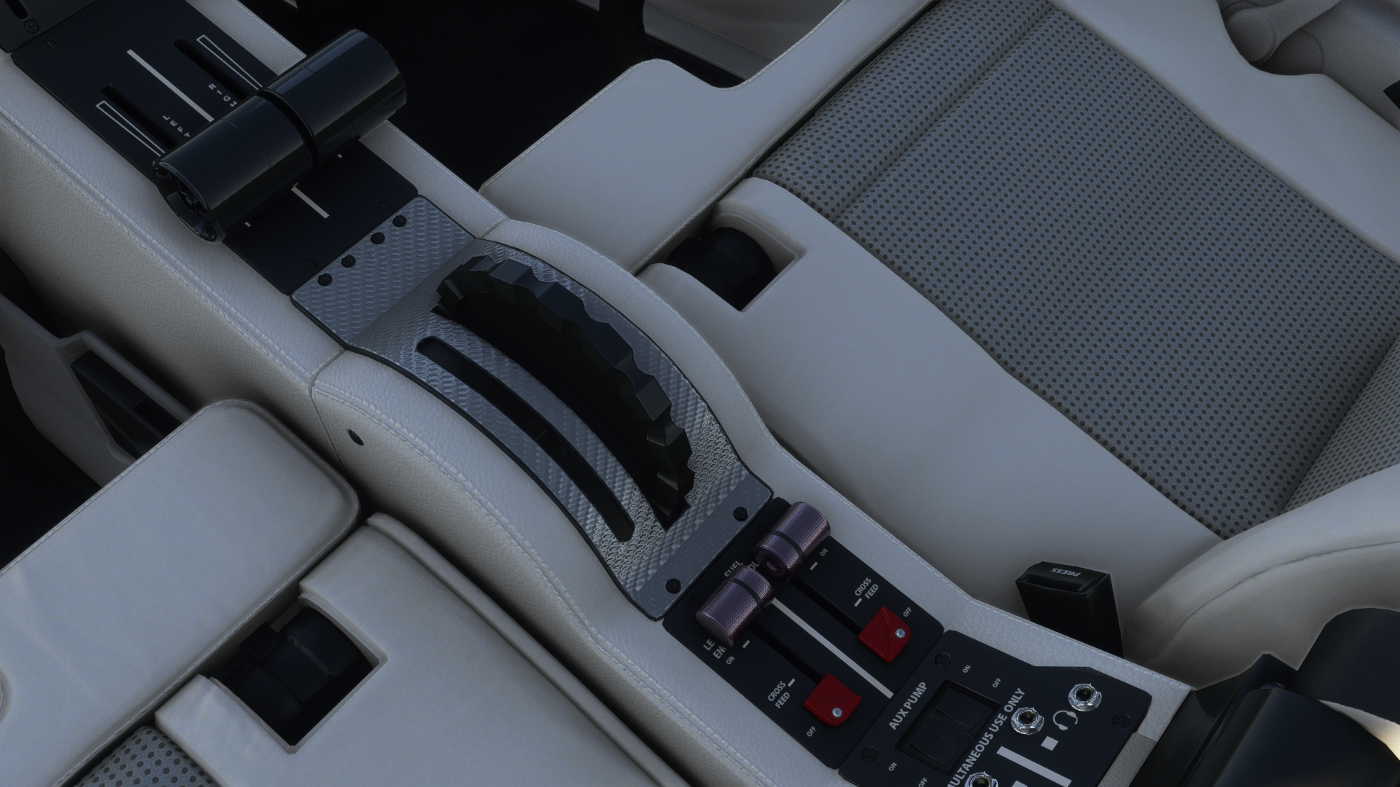
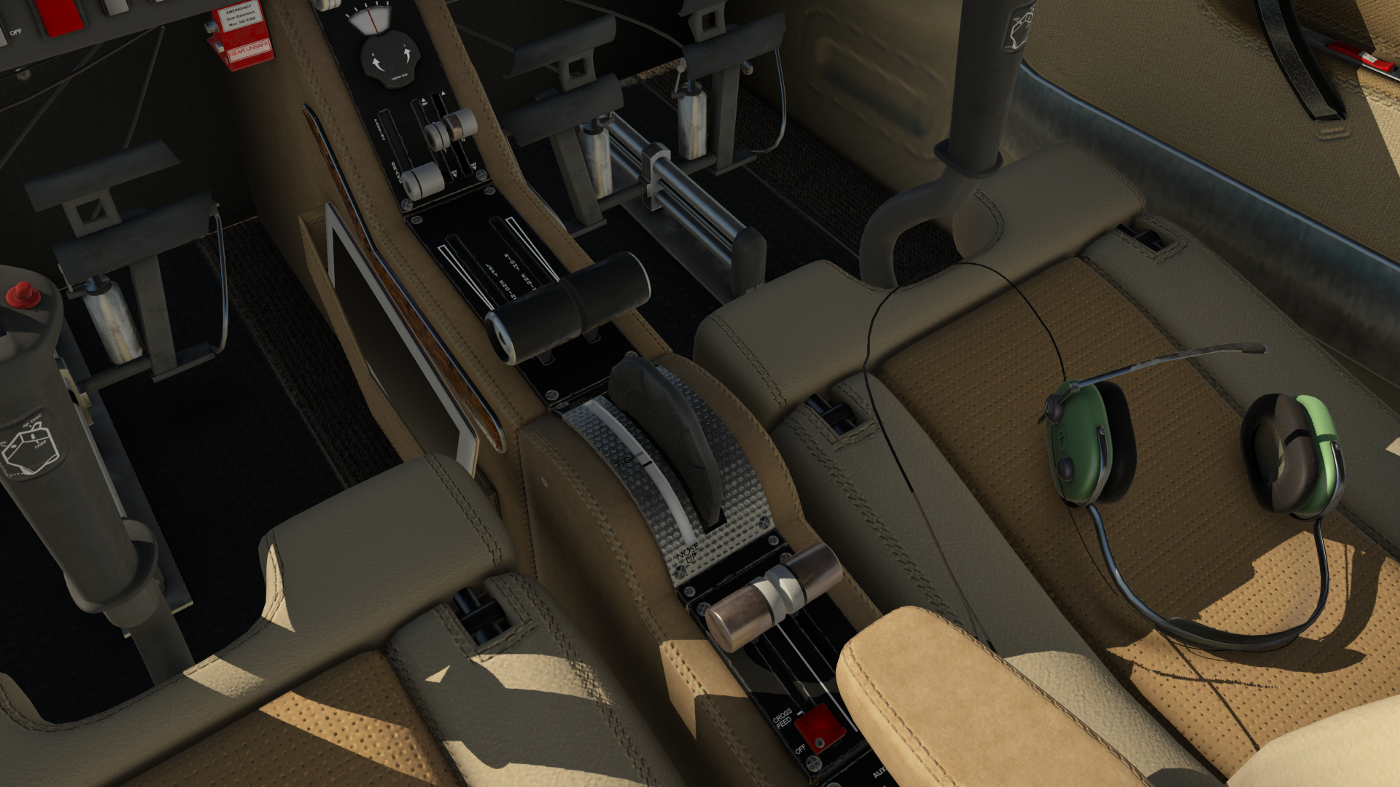
Now, someone might point out that you can move to external view and view the trim indicator, and that by default when the plane is started the trim is set to takeoff. I say, that?s irrelevant. I need to be able to fly the plane by configuring according to SOP? and I can?t do that if fundamental indicators in the cockpit are missing.
To round up my systems bashing, there are no systems to bash, because they?re not modeled. XP11 has a fully functional, if generic, FMS for all of its default aircraft. FS2020 doesn?t even have one. And in XP11, fundamental systems like trim wheels actually work in default aircraft.
The Reason for these Issues
This brings me on to the question I?ve been asking since I started playing FS2020: why does it have all these issues? After all, if we could get simulators right in 2016, how have we taken such a monumental leap backwards in realism? The answer lies in that external view camera.
With the exception of the DSim-42, every single simulator I?ve used has an external view ? so what makes this one different? Well, none of these simulators has an external view with a full suite of instruments available as well. This game is meant to be played in external view. The gauges read correctly, the system indicators work, and you can see that mesmerising scenery without a pesky cockpit getting in the way. When, for the benefit of my parents, I switched to external view to show off the visuals over Vancouver, I was stunned at how much instrumentation there was available. In XP11, switching to external view is something I do only on autopilot or in replay mode ? you can?t fly the plane from outside. In FS2020, you can. And in external view, you forget about all these things like performance numbers and handling, because you get to see the world in all its glory ? and I truly don?t mean that facetiously.

FS2020 is a monumental achievement in simulating the world visually. It genuinely allows people to experience the world in a way they never could before. Always wanted to visit the Pyramids? See Mount Everest? Overfly the South Pole? You can literally go anywhere in the world and get an almost photo-real look at it ? and I think that?s an incredible thing to be able to do. What Asobo has created is a breathtaking look at the beauty of the world through the lens of aviation. It?s a work of art.
You can have an amazing time in FS2020. I smile with glee flying over London at 200 feet buzzing Buckingham Palace. And I love how it gives me that awe-inspiring sense of scale ? the feeling of being in a tiny little mechanical contraption and looking out over the vastness of the earth. It?s an evocative, emotional experience.
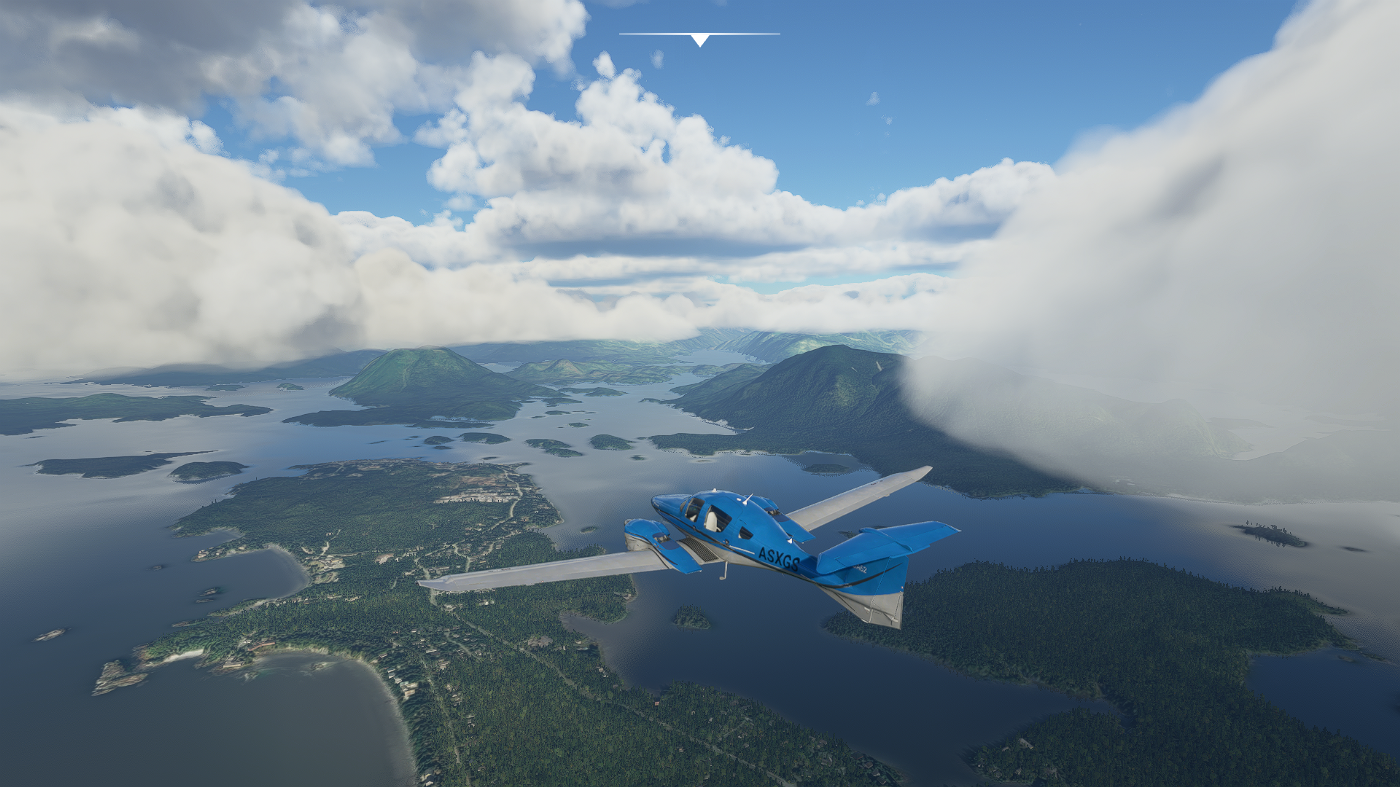
Sadly though, it?s not the revolutionary flying simulator I hoped it would be. As a pilot, it makes me sigh. It?s unfinished ? that the kindest I can be. But unfinished isn?t good enough when there?s been a simulator around for 5 years that can do everything FS2020 can do simulation-wise, and do better.
XP11 might only be the first-word in scenery, but the OrbX add-on, while expensive, makes it more than good enough to enjoy flying IFR. Heck, even the default scenery is useable, and it has the benefit of not sapping your framerate. Even for VFR, I would recommend default XP11 over FS2020 if the flying experience is what you?re after. It might not look as nice, and some of the landmarks might not be real, but it teaches you skills. You might not learn to use that landmark to navigate, but you?ll be using a landmark ? that?s what VFR navigation is about.
Furthermore, XP11 is a fantastic training tool for emergencies. For me, the biggest draw of a simulator is being able to experience unexpected failures and respond to them in real time with realistic consequences. It?s good practice for procedures, but more importantly, it trains you to never take reliability for granted, and always think about your options. XP11 has a fully comprehensive, randomisable system failure model. You can set any system to fail, whenever you want it to (or not, depending on how you look at it). FS2020 only simulates critical system failures, and those aren?t randomisable. FSX had something close to XP11’s functionality back in 2005, so I have no explanation for the regression.
In my opinion, FS2020 fails to teach people about aviating. The ?point and shoot? flight model that lets you maneuver telepathically and the systems model that tells you nothing are critical omissions in flying terms. Sure, it?s an incredible tool for letting people experience the magic of aviation, but it?s not a flight training aid. If you?re an aspiring pilot, real or virtual, buy XP11. It will actually teaching you something about flying.
In conclusion, FS2020 has some things to teach XP11, but it?s nothing like the existential threat everyone purported it to be. If you want an unparalleled visual experience in one of the most immersive open-world experiences around, buy FS2020. If you want to fly, don?t. It pains me to say that because I had huge hopes for this game, but in the end it is just that ? a game.